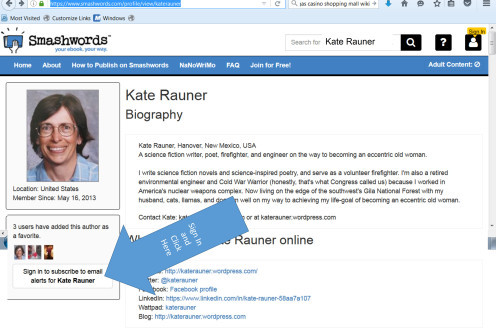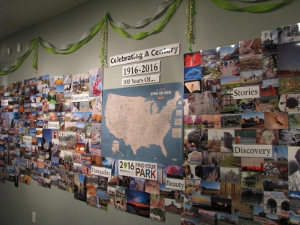Kate Rauner's Blog, page 67
November 26, 2016
Holiday of Turkeys #happythanksgiving
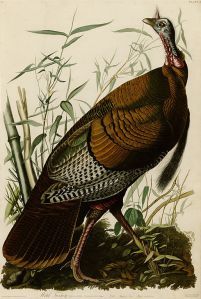 My best wishes to you as the Holiday Season gets underway. Let’s not forget Thanksgiving too quickly.
My best wishes to you as the Holiday Season gets underway. Let’s not forget Thanksgiving too quickly.
More great turkey pictures from NatGeo
Filed under: Neat Science News








November 18, 2016
Build a Waterfall on Mars #Mars #scifi #book
Water on Mars is now available!
Join Bliss as she leaves her tiny fish-farming burg for the largest city on
Mars – six hundred eighty-one settlers. She’s interning on a project to build a pressurized waterfall park inside a huge lava tube – which should be fun. But she’ll have to work in a surface suit and deal with a crazy team leader, all while discovering the city life has its own dangers. Even cargo coming from Earth – for the first time in generations – may be disastrous. And she thought this was the best time to be alive on Mars.
Hurray – I made my deadline and got the fourth book in my Mars colonization series published. Had some trouble getting the table of contents to load correctly (grr), but I think it’s good now.
The book is available now on Smashwords for 50% off. Use coupon code NV59B before the end of 2016. Find out what the watermelon on the cover is all about. Coming next week to Amazon (assuming I got that table of contents right), and soon after to your favorite online bookseller. The paperback edition will be available by the end of the year – in time for Christmas if everything works out okay. Like Dicken’s ghost of Christmas Yet-To-Come, paperbacks appear in their own good time.
I hope you’ll enjoy Water on Mars – let me know what you think. And catch up on my books, including the On Mars series, at Amazon, Barnes & Noble, iTunes, Kobo, and other major online retailers. You’ll also find paperbacks at Create Space and all major digital formats at Smashwords. Read one today.
Filed under: Kate's Books, Science Fiction Tagged: adventure on Mars, colony on mars, lava tube, new adult, science fiction, science fiction by women, SciFi, ya








November 12, 2016
Flailing Towards a Deadline #amwriting #scifi
I am absolutely determined to publish my next book in the On Mars series by the end of the month, so my creative
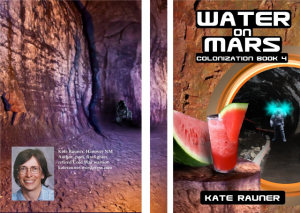
New cover is nearly done
brain cells and writing time have been dedicated to the project. If you’re a regular reader you know my other postings have suffered – hope you’ll forgive me, but I’m obsessed.
I’m playing with a blurb for the book. Would this catch your interest? Is “dangers lurk” too much of a cliché?
Maybe Mars’ largest city isn’t all fun.
Welcome to the third book of the On Mars series, a hundred years in your future. Bliss wants the fun and excitement of life in the colony’s biggest city – a village by Earther standards but a city on Mars – and is happy to take the first intern job she finds, even if it takes her out on the planet’s hostile surface. But dangers lurk inside the colony, and even cargo arriving from Earth – the first shipment in generations – may bring disaster. Join her to discover if humans can survive on a hostile planet and make it a home.
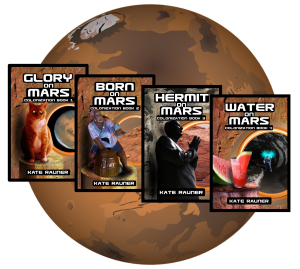 All my books, including the On Mars series, are available at Amazon, Barnes & Noble, iTunes, Kobo, and other major online retailers. You’ll also find paperbacks at Create Space and all major digital formats at Smashwords. Catch up now.
All my books, including the On Mars series, are available at Amazon, Barnes & Noble, iTunes, Kobo, and other major online retailers. You’ll also find paperbacks at Create Space and all major digital formats at Smashwords. Catch up now.
Filed under: Kate's Books, Science Fiction Tagged: colony on mars, new book, science fiction, SciFi, space, travel to Mars








November 5, 2016
Water on Mars Chap 1 #Mars #scifi #book #free
“The significance of our lives and our fragile realm derives from our own wisdom and courage. We are the custodians of life’s meaning.” Carl Sagan
Prologue
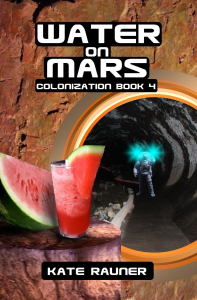 Settlers arrived on Mars generations ago, sent by rivals on Earth. Kamp Kans was the first colony, established by visionaries from Europe’s Low Countries near the volcanoes of the Tharsis Bulge. Half a planet away, Fenghuang District was sent by a Sino-African cartel to the lowlands of Utopia Planatia. Neither Earther group could bear the vast expense of interplanetary missions for long, so the few dozen colonists joined together in a struggle to survive on their own. But survival of the Earth-borns wasn’t enough. If humans were to make the hostile planet their home, the colony had to grow.
Settlers arrived on Mars generations ago, sent by rivals on Earth. Kamp Kans was the first colony, established by visionaries from Europe’s Low Countries near the volcanoes of the Tharsis Bulge. Half a planet away, Fenghuang District was sent by a Sino-African cartel to the lowlands of Utopia Planatia. Neither Earther group could bear the vast expense of interplanetary missions for long, so the few dozen colonists joined together in a struggle to survive on their own. But survival of the Earth-borns wasn’t enough. If humans were to make the hostile planet their home, the colony had to grow.
Iron and copper was found near Kamp, and water and air were relatively plentiful at District. When prospectors discovered technology metals in the Tartarus Mountains, midway between the settlements, the settlers could finally fabricate more equipment, including squads of robots to work on Mars’ surface. From their new Cerberus Base, roboticists constructed a transit corridor to unite Kamp and District and, spaced along the route, they built burgs that each specialized in a vital technology. Now, no disaster at any one habitat could destroy the colony.
Finally feeling secure, the settlers had planned for everything except what happened.
Chapter One: Kamp Kans
Bliss stopped in the archway. The transit corridor was behind her and the largest city on Mars was in front, home to half the settlers on the planet, six hundred eighty-one people. She stepped through the arch. Now there were six hundred eighty-two. It looked like all of them were swarming through the plaza.
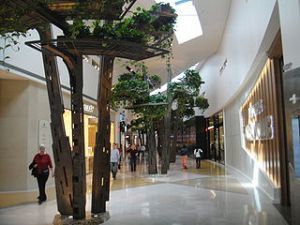
Inspiration for how to design an underground colony – a shopping mall inside a Las Vegas casino – this is much nicer than Kamp on Mars
Apprehension tinged Bliss’s excitement. Kamp’s plaza was a standard colony bay, a hundred paces long, but at home there were only twenty-four settlers. In front of Bliss was a whirl of people like a human sand storm reverberating with sound. A man erupted from the throng and headed straight towards her at a gallop.
“Hey, you!” A woman in crisp khaki coveralls ran after him.
Bliss jumped back only to bump into someone behind her. She spun around, apologizing.
Whomp.
“Hello, little lady.” Bliss had a glimpse of a scraggily beard and a grin full of teeth as the man grabbed her elbow to steady her, then disappeared down the corridor.
“So, you’re in league with that miscreant.” The khaki woman planted herself in front of Bliss, fists on hips. She interrupted Bliss’s confused stammer to point straight at her chest.
Bliss looked down to find a small bolt of fabric in her arms. The grinning man had slammed it against her and her hands reflexively clutched the short roll.
She held the fabric out, trying to explain.
“I’ve never seen you before.” The woman’s eyes narrowed but she made no move to take the roll.
“Give the girl a break.” A circle of people had formed around them and another man pushed through. “I was watching. That Basic dumped it on her.”
“If this is yours, please take it.” Bliss held the fabric out. “I don’t know anyone here. I’ve only just arrived from Hibes.”
“You nederlanders need to get smart in a hurry.” The khaki woman took the roll. “You’re in Kamp now.”
Individuals disappeared back into the crowd.
Bliss slid through the horde to stand with her back against the plaza’s central pond. Her heartbeat slowed as she regained her equilibrium.
The woman called her nederlander. She didn’t understand exactly what had happened, but that was no reason to tag her as stupid. Stupid because she came from a burg, one of the small habitats strung along the colony’s transit corridor.
She plucked at her own shapeless coveralls. She’d scrubbed the smell of Hibes’ fish farm from them, but the fabric was worn thin in places and patched in others. Maybe she was a nederlander, but she had the same Basic Education as anyone on Mars. She had her new adult-qualification badge and an internship. And she planned to find a permanent job. She’d be a real Kamper soon, part of the colorful crowd surging through the plaza.
If she’d somehow made a mistake this sol, she’d apologize to the khaki woman. But later. Bliss had been traveling twenty-four and a half hours a sol for five sols, stopping at transit stations only to grab a meal and switch to a taxi with a charged battery.
I won’t look for that woman now, she thought. It made sense to follow her original plan tonight and her enthusiasm returned with the decision.
Bliss wanted excitement in her life and her arrival proved this was no boring little burg like Hibes. This was the much-expanded home of twenty-eight Earth-borns who’d arrived on Mars eight generations ago. Named in honor of an old robotic mission by Dutch visionaries who launched the colony, it was Kamp Kans – Opportunity Site. The first habitat was once called a nederzetting, she reminder herself. It was an honorable term. But she was a Kamper now.
She squared her shoulders and tipped her chin up proudly, defying any doubts.
Bliss had planned this move for as long as she could remember, all through Basic Education. Now she was here.
***
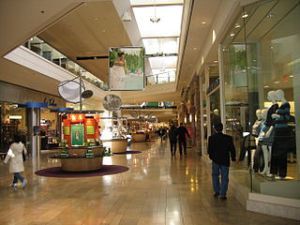
Another view of a lovely casino shopping mall – but Kamp is built of stone fabricated from the orange Mars sands
It was supper time and Kampers streamed by, headed through an archway that must lead to the cafeteria. Bliss smiled tentatively, but people hurried by without a sideways glance. When she did catch someone’s eye, they nodded back pleasantly enough. Most were dressed in khaki coveralls, clean even at the end of the sol, but there were frequent splashes of colorful shirts and bandanas. Kamp was a prosperous city and people had more than Basic goods.
Bliss leaned against a central pond built of waist-high stone and saw it didn’t simply house fish. Instead of aerators, a fountain burbled over decoratively stacked rocks at each end. Its sides were gleaming white, contrasting beautifully with the floor of massive stone fabricated from Martian sand in splotches of beige, brown, and orange. Fabricated walls curved to a barrel-vaulted ceiling that seemed higher than her home plaza, though she knew the bays were standard construction. It must be the colors and sounds that made Kamp’s plaza feel so big.
Bliss crossed the plaza with a light step, her pale auburn braid bouncing against her backpack. She was a city girl now, on her own for the first time, and she planned to enjoy every sol. She started by browsing kiosks selling Extras. It was like visiting every burg on Mars, only better. There were dates from Planitia Hamlet, apples from Olympus, and fabrics woven from Amenthes’ bioreactor outputs.
“Bliss!”
She spun around, startled at the sound of her name.
“Beeb, who’s calling me?”
“That is Nia calling you.” The colony’s Artificial Intelligence responded through her ear gel. “Her kiosk is to your right.”
Oh, yeah, Nia lived in Kamp now. She’d raised a family in Hibes and was an aunt to Bliss – her children were Bliss’s kinderen cousins. Last jaar Nia returned to Kamp, her childhood home, when her last boy adult-qualified. Only my parents, Bliss thought, want to spend their whole life in Hibes, smelling of fish guts and mealworm bedding.
She spotted the short, energetic woman and waved.
Nia kept ties with Hibes and bought their mealworms to sell, spiced using a recipe Bliss’s parents had developed. Bliss breathed in the familiar smell as she approached a sample bowl on Nia’s counter and reached for a worm. She had to admit, they were delicious, and reached for another.
“None of that, girl,” Nia said sharply. A tight pony tail emphasized her wide face and stern expression. “Your mother told me you’ve got a position in Kamp, so you can buy a bag like everyone else.”
Bliss gripped her pack’s shoulder straps with both hands to keep them from wandering back to the worms. A man waiting at the counter chuckled.
Nia handed the man a bag of freshly fried worms, reached into a tub behind the counter, and dumped a handful into a pan.
“Don’t be telling your mother they aren’t fresh,” she said as Bliss leaned forward and frowned at the pan. “I freeze them before cooking. Kampers don’t like to see their mealworms writhing when they hit the heat.
“When do you start your job?” Nia asked.
“In a couple sols.”
“I could use some help. Want a job in the kiosk until then?”
“Oh, no,” Bliss said. “I came early so I can look around.”
Nia harrumphed with a parental sort of disapproval. But Bliss clamped her lips together tightly, refusing to be swayed.
“Which job did you get?” Nia asked without looking up from her pan.
“Building a public park. The first one on Mars.”
“That’s Vance’s project, isn’t it? You’ll be working in a surface suit. Did you know that?”
“Of course.” The project sounded grand, though Bliss didn’t know much more than what she’d told Nia. The intern posting was vague. She hadn’t told her parents it required surface-qualification, though of course her father looked it up. With her mother, he tried to talk her out of taking the job, saying risks on the surface were too great for a recreational park, for anything non-essential.
She said goodbye to Nia without buying any mealworms and slipped back into the crowd.

Join Bliss in her lava tube
Despite being a Kamper, Nia had fit in with Bliss’s parents at Hibes – practical like they were and always working. Bliss understood why there was little time for play. There were as many tasks vital to survival in a little burg as in a city. Life support had to be maintained with human hands – all those pumps and compressors and fans. Ignoring a rattle or leak could lead to a system failure. Mars was a deadly planet and technology kept them alive.
Beyond life support, wastes had to be recycled, clothes cleaned, food cooked – and then the fish and mealworms tended. While Bliss was growing up there were only eight adults in Hibes with their gaggle of children, so she learned to work hard, even if she couldn’t resist sneaking off sometimes to play games or view entertainments. She’d always felt guilty when her mother tracked her down in some corner, but she also knew there was more to life than raising fish and children.
Of course, one thing her parents never did was go out on the planet’s surface. Each burg had a squad of robots to construct new bays and harvest air and water from the scant supply in Martian sand dunes. Not a large squad like the one constructing bays for Kamp, just three bots controlled by the colony’s AI. But when they needed human maintenance, specialists came to Hibes.
A surface requirement added a thrill to the intern posting. Bliss was glad her parents had argued with her, because that gave her a reason to dig in her heels. Being contrary had advantages. It ensured she applied for the position, guaranteed she’d accept it, and made it easy to push any of her own misgivings aside.
People go out on the surface all the time, she’d told her parents with exaggerated patience. It’s perfectly safe.
###
Water on Mars coming in late November 2016 – two ways to ensure you don’t miss the release. Subscribe to my Reader’s Club or sign up with Smashwords. Don’t miss out! An in the meantime, catch up with the first three On Mars books.
Filed under: Kate's Books, Science Fiction Tagged: colony on mars, fiction, hardscifi, hardsf, latest, mars, new book, science fiction, SciFi, settlement on mars, settlers, sf, what will a colony on mars be like








October 29, 2016
Caterpillars and High-Tech #nature #tech #science #nanotech #innovation
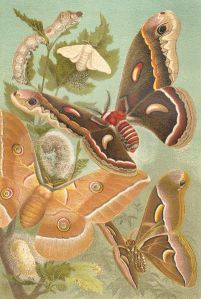
Silkworms make beautiful moths, too
Silk—the stuff of lustrous, glamorous clothing—is very strong. Researchers now report a clever way to make the gossamer threads even stronger and tougher: by feeding silkworms graphene or single-walled carbon nanotubes cen.acs.org
Silkworms may be humanity’s favorite caterpillar. For over five thousand years, silk from these bugs’ cocoons has produced a protein-based thread that is strong as well as beautiful. Can technology improve on nature’s fiber?
Fabrics can, of course, be treated with dyes or preservatives, but by spraying mulberry leaves – silkworm food – with graphene or single-walled carbon nanotubes, the silk will be even stronger and can conduct electricity. Or feed the caterpillars titanium dioxide and increase silk’s resistance to UV light.
This new material may be useful in biodegradable medical implants or ecofriendly wearable electronics.
Carbon nanotubes have extraordinary properties. Without being incorporated into silk, they’re used in resins for wind turbines, marine paints, skis, baseball bats, hunting arrows, and bicycle components.
A novel radical initiated thermal crosslinking method to fabricated macroscopic, free-standing, porous, all-carbon scaffolds using single- and multi-walled carbon nanotubes as building blocks [whew, there’s a mouthful]… may be used for the fabrication of the next generation of energy storage, supercapacitors, field emission transistors, high-performance catalysis, photovoltaics, and biomedical devices and implants… Carbon nanotubes have been identified as possibly being able to meet the specific strength requirements for an Earth space elevator. wikipedia here and here.
Under some conditions, these compounds can migrate into living cells, so safety is an evolving concern and nanomaterials probably shouldn’t be added willy-nilly to products, especially not to simply be trendy. But with so many applications, we’re bound to see more of them. It would be grand if our ancient friend the silkworm could help us understand more about a cutting edge material.
Filed under: Neat Science News Tagged: are nanomaterials harmful to the environment, carbon nanotube, caterpillar, graphene, moth, mulberry silkworm, nature, silk, space elevator








October 27, 2016
Listen to Science Fiction Fantasy
"600 Second Saga is a weekly science fiction and fantasy podcast. Every week we feature an author and their vision of the fantastic, futuristic, and far-fetched. Each tale is an escape in less than ten minutes to a world of epic fantasy, cyberpunk, shifters, aliens, magic, and more."
These short tales are perfect for a break anytime. And you'll find one of my stories :) Mysterious Ways about an angel on Mars.
But there's lots to choose from - you're sure to find something you'll like. Check it out.
October 23, 2016
Eureka – Maybe #Mars #searchforlife #poem #poetry #NASA

Big Joe, a Martian rock Viking One studied
Earth first touched planet Mars
On the Golden Plain,
When forty years ago
The search for life began.
Where barren outflow channels
From the Tharsis ridge
May once have carried water,
Where something might have lived.
Viking One took images,
Surveyed the dunes nearby
And analyzed geology
Beneath the pinkish sky.
Its tests for life seemed negative,
But we don’t understand
Why something used the nutrients
Dripped on a bit of sand.
We’ve learned so much in forty years,
We found Martian organics,
Maybe Viking did discover
Cryptobiotics.
by Kate Rauner
It’s possible we have seen life processes on Mars. Thanks to phys.org for covering Gilbert V. Levin’s and Patricia Ann Straat’s paper “The Case for Extant Life on Mars and Its Possible Detection by the Viking Labeled Release Experiment.”
In which they reconsider the results of the Viking LR experiment in light of recent findings on Mars and recent proposals for inorganic substances that may mimic the observed metabolism-like processes. They argue that none of the proposed abiotic substances sufficiently explains the Viking results, and that Martian microbes should still be considered as the best explanation of the results. In Astrobiology, October 2016, 16(10): 798-810. DOI: 10.1089/ast.2015.1464
Not proven – but – wow.
My books include science fiction stories of the first colony on Mars and collections of my science-inspired poetry, are available at Amazon, Barnes & Noble, iTunes, Kobo, and other major online retailers. You’ll also find paperbacks at Create Space and all major digital formats at Smashwords. Read one today.
Filed under: Neat Science News, Poetry Tagged: Labeled Release (LR) experiment, mars, NASA, poem, poetry, search for life on Mars, solar system, Viking 1, Viking One Lander








October 19, 2016
Why is the Night Sky Dark? #star #science #mystery #astronomy
 There are billions of stars in every direction. Even more than we used to think – photons aimed straight at us from every point in the sky. As NASA puts it,
There are billions of stars in every direction. Even more than we used to think – photons aimed straight at us from every point in the sky. As NASA puts it,
the trouble with an infinite universe is that no matter where you look in the night sky, you should see a star. Stars should overlap each other in the sky like tree trunks in the middle of a very thick forest. But, if this were the case, the sky would be blazing with light.
This is the famous Olber Paradox. Though articulated in the 1800s for an infinite steady-state universe, it still offers a puzzle today. The universe may not be infinite, but it’s very very big with very very many stars. Why do I see so much dark sky between stars?
Because the universe is expanding, the light that reaches us is subject to a phenomenon called “redshift…” the wavelengths of light [stars] emit appear to stretch out. Go far enough, and the light will redshift below the level discernible by the human eye, and eventually telescopes.
Some of this radiation shows up as background light, a faint diffuse glow of light that appears to have no source. The rest, however, disappears before it ever reaches us.
Thanks to Astronomy.com for the explanation. Try to remember this for when some little kid asks.
Filed under: Neat Science News Tagged: astronomy, Hubble space telescope, light, NASA, redshift, stars, why is the night sky dark








October 15, 2016
When Living in the Physical World #poem #poetry #carlsagan #skeptic
If you’re only skeptical,
If you always doubt,
Ideas never make it through.
Where’s the joy of something new?
But if you are gullible
You’ll fill your head with trash.
If proposals all are equal
You’re thoughts are so much treacle.
You needn’t choose between
A crotchety coot or a dupe.
When living in the real world,
Both extremes are absurd.
There is a way that does it
In a balance most exquisite –
Scrutinize hypotheses,
Stay open to the novelties.
by Kate Rauner
I was reminded of Carl Sagan’s fine advice at Brainpickings. Sagan’s original article seems to have been taken down, but the fine quote here is worth reading.
 All my books, including collections of my science-inspired poetry, are available at Amazon, Barnes & Noble, iTunes, Kobo, and other major online retailers. You’ll also find paperbacks at Create Space and all major digital formats at Smashwords. Read one today.
All my books, including collections of my science-inspired poetry, are available at Amazon, Barnes & Noble, iTunes, Kobo, and other major online retailers. You’ll also find paperbacks at Create Space and all major digital formats at Smashwords. Read one today.
Filed under: Poetry Tagged: Carl Sagan quote, how to be skeptical, poem, poetry, reality in the physical world








October 8, 2016
Carlsbad Cavern National Park #findyourpark #cave #travel #nature
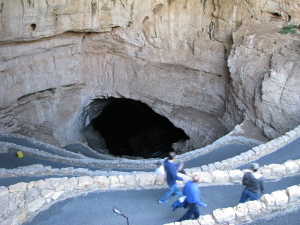
Snapshots don’t convey the scale – you’ve got to go.
Here’s my advice. Visit Carlsbad Cavern after peak season and arrive as the Visitors’ Center opens. No guided tour for your first descent. Take the footpath that corkscrews down through the natural entrance. Let your steps rouse cave swallows lingering on their perches. Feel the depth.
Imagine ancient Native Americans setting fires every so often as they climbed, passing wood down from the surface to enter a holy place. Or the first Anglo cowboy, sliding across wet rocks, the feeble light from his candle unable to breach the darkness above.
Walk among immense slabs. Did any humans hear the 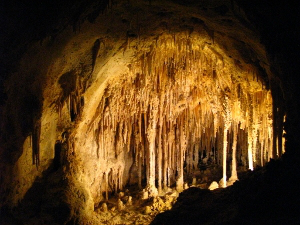 echoing thunder when they fell from the ceiling or walls? Surely that was the voice of gods.
echoing thunder when they fell from the ceiling or walls? Surely that was the voice of gods.
Without the crowds – up to 5,000 visitors on a peak day – you’ll have passageways to yourself and share the big rooms with the brothers and sisters of your soul.
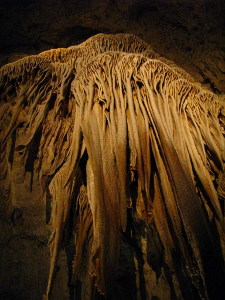 Down and down. On and on. Straws and curtains, stalactites and stalagmites, columns and domes, calcite lilies and cavern pearls – tinted sepia in the artfully positioned lights – decorate a gloom that, in the cavern’s natural state, is impossibly black.
Down and down. On and on. Straws and curtains, stalactites and stalagmites, columns and domes, calcite lilies and cavern pearls – tinted sepia in the artfully positioned lights – decorate a gloom that, in the cavern’s natural state, is impossibly black.
The rangers say hundreds of thousands of individual features have been broken off and carried away by 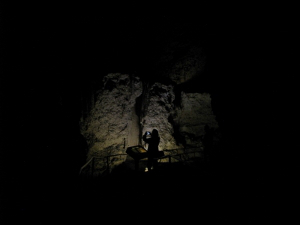 souvenir hunters, perhaps starting when the last Ice Age receded but mostly since the 1800s. But the cavern is so enormous, its ceiling so high and walls so steep, that vastly more features were beyond greedy reach and remain untouched.
souvenir hunters, perhaps starting when the last Ice Age receded but mostly since the 1800s. But the cavern is so enormous, its ceiling so high and walls so steep, that vastly more features were beyond greedy reach and remain untouched.
They say strings of adjectives betray a writer’s poor grasp of language. So be it. I am overwhelmed.
Vast. Magnificent. Spectacular. Humbling. Breathtaking. Inspiring. Mystical. Endless.
Filed under: Neat Science News Tagged: Carlsbad Cavern National Park, cave's natural entrance, National Parks' Hundredth Anniversary, nature, see for yourself, tourists, wildlife









